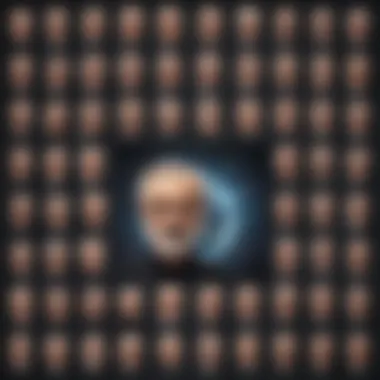Impactful Discoveries of Nobel Physics Laureates


Intro
The Nobel Prize in Physics serves as a prestigious recognition of extraordinary accomplishments in the realm of physical sciences. Each laureate, through their indelible contributions, has shaped the trajectories of research and technology, influencing not only their fields but also the broader societal context. This article aims to critically analyze the achievements of these distinguished individuals, placing emphasis on their notable discoveries and the far-reaching implications of their work.
Through this exploration, the article will highlight key points, such as how specific findings have led to advancements in technology and our understanding of the universe. By delving into individual stories of laureates, readers will gain insight into the dynamics of scientific advancement, as well as the collaborative nature of research and discovery. This framework aims to provide clarity on complex concepts while engaging a diverse audience interested in the evolution of physics.
Key Research Findings
Overview of Recent Discoveries
The contributions of Nobel Prize winners in Physics resonate through leading-edge discoveries, showcasing the interconnectedness of theoretical insights and experimental breakthroughs. Recent laureates like Alain Aspect, John F. Clauser, and Anton Zeilinger received the award for their pivotal work in quantum entanglement, fundamentally reshaping our understanding of quantum mechanics and its applications in quantum computing, cryptography, and communication.
The innovations stemming from their efforts provide a rich landscape for exploration. Their collective work not only elucidates the bizarre phenomena of quantum behavior but also sets the foundation for future technological advancements that may redefine our interaction with information.
Significance of Findings in the Field
The significance of these discoveries extends beyond mere recognition. For instance, the application of quantum entanglement is poised to revolutionize secure communication and develop unhackable networks known as quantum key distribution systems. The implications of such breakthroughs underscore the importance of these findings, as they pave the way for unprecedented security measures in an increasingly digital world.
"The profound implications of quantum technology promise shifts in our understanding of privacy and data security that were once confined to the realm of speculation."
Breakdown of Complex Concepts
Simplification of Advanced Theories
Understanding the dense theoretical frameworks presented by Nobel laureates can be a challenging venture. By breaking down complex theories like the Standard Model of particle physics or string theory, we can foster a clearer comprehension among students and enthusiasts. For instance, explicating the role of the Higgs boson alongside its discovery highlights how fundamental particles interact and solidify our grasp of fundamental forces.
Visual Aids and Infographics
Utilizing visual aids, such as diagrams and infographics, can significantly enhance the learning experience. Clear depictions of experimental setups, particle interactions, and the implications of major discoveries can offer intuitive grasp of physics concepts that are otherwise abstract. Engaging with content that utilizes visual structures can bridge the gap between theoretical research and practical understanding.
Through this comprehensive exploration, readers will unravel the complexities and nuances of each Nobel laureate's contributions. As we delve deeper into their stories, a clearer picture of the collective achievement in the field will emerge.
Foreword to the Nobel Prize in Physics
The Nobel Prize in Physics represents a pinnacle of achievement within the scientific community. It highlights the contributions that have fundamentally shaped our understanding of the physical world. This accolade not only honors individual brilliance but also serves as a reflection of the evolution of physics as an essential field of study. By delving into this topic, we unveil the layers of significance surrounding the prize. It informs us how scientific quests lead to breakthroughs that influence contemporary society.
Discerning this subject matters greatly. The Prize amplifies the legacy of its laureates, encouraging aspiring physicists and researchers to pursue innovation and discovery. Furthermore, discussing the contributions of Nobel winners contextualizes ongoing scientific conversations. Analyzing their work illuminates pathways for emerging scholars.
Historical Background
The Nobel Prize was established in 1895, following the last will of Alfred Nobel, a Swedish inventor and philanthropist. Initially, its purpose included categories such as Physics, Chemistry, and Medicine. The first Nobel Prize in Physics was awarded in 1901 to Wilhelm Röntgen for his discovery of X-rays. This marked a significant moment, as it grounded the recognition of outstanding contributions to physics in a formal context.
Throughout history, notable physicists such as Niels Bohr, Marie Curie, and Albert Einstein have received this distinction. Their findings often drove the field forward, addressing complexities that shaped modern physics. From early quantum theories to advancements in particle physics, the array of work recognized is vast and varied.
Purpose and Significance
The purpose of the Nobel Prize in Physics extends beyond mere recognition. It serves as an incentive for continued exploration and innovative thought in physics. When a physicist is awarded, it highlights the practicality and impact of their discoveries. The Prize emphasizes that foundational research can lead to transformative technologies, influencing various aspects of daily life.
Significantly, the nobel laureates contribute to an intellectual legacy. Their work often establishes frameworks that inform future research. For students and educators, this information is vital. Understanding what has been accomplished allows for a better grasp of where the field is heading. Additionally, it sparks interest among those newly entering the discipline.


In summary, the Nobel Prize in Physics is not only a prestigious award; it represents a crucial intersection of historical significance and foresight in scientific inquiry. Its role continues to shape discussions and findings that emerge in the realm of physics.
Criteria for Selection
The Nobel Prize in Physics is not just an accolade; it's a ceremony that recognizes exceptional achievement in the field. The process that leads to the selection of awardees is intricate and emphasizes the importance of rigorous evaluation. Understanding the criteria for selection highlights how esteemed contributions are identified and rewarded.
This section delves into the eligibility requirements and the evaluation process essential for selecting nominees for this prestigious award.
Eligibility Requirements
To be considered for the Nobel Prize in Physics, candidates must demonstrate outstanding accomplishments in research, theory, or application in the realm of physics. The key elements for eligibility include:
- Original Contributions: The work submitted must showcase a significant advancement or discovery in the field of physics. It cannot merely be reiteration of existing theories.
- Peer Recognition: Typically, nominees must have garnered respect and recognition from fellow physicists. This often influences their recommendations, thus highlighting the communal aspect of scientific advancement.
- Publication: Most contributions should be published in peer-reviewed journals. This allows for scrutiny and validation of findings by the global scientific community.
- Timeliness: The relevance of the work is taken into account. Discoveries that address pressing scientific questions or expand understanding in contemporary contexts are given precedence.
Evaluation Process
The evaluation process for the Nobel Prize in Physics involves multiple steps that advocate for a thorough assessment. The Nobel Committee, comprising distinguished scientists from various domains, undertakes a detailed review of nominations. Here are the essential steps:
- Nomination: Qualified individuals such as past laureates, members of academies, and notable physicists propose candidates. This creates a broad base of potential nominees each year.
- Preliminary Review: The committee assesses all nominations and selects a shortlist. Factors like prestige of publications and novelty of ideas are extensively reviewed.
- Expert Consultations: To ensure that all aspects of the work are evaluated, the committee consults with external experts. This step is critical to validate the significance and impact of the proposed work across diverse sub-disciplines.
- Final Decision: After thorough deliberation, the committee reaches a decision. The names of the laureates are kept confidential until the announcement, ensuring that the unveiling is a moment of surprise and celebration.
The selection of Nobel Prize winners is thus both a scientific and a community-driven process, reflecting deep understanding and collaborative respect within the physics community.
Understanding these criteria allows one to grasp the weight and depth of achievement required for receiving the Nobel Prize. Physical sciences are continuously evolving, and the criteria for selection underscore the role that exceptional contributions play in moving the field forward.
Notable Nobel Prize Winners in Physics
The Nobel Prize in Physics recognizes individuals whose contributions have significantly enhanced the field. Each laureate's work often raises new questions and builds the foundation for future research. This section explores the groundbreaking efforts of notable physicists, focusing on their unique contributions that shape our understanding of the physical world. Their discoveries demonstrate not only the evolution of physics but also its impact on technology and society at large.
Marie Curie’s Pioneering Research
Marie Curie's work in radioactivity was revolutionary. She was the first woman to win a Nobel Prize and remains the only person to earn Nobel Prizes in two different scientific fields: Physics and Chemistry. Her discovery of radium and polonium marked a significant advance in our understanding of atomic structure. Curie's meticulous research provided insights into the properties of radioactive materials.
Her findings laid the groundwork for advancements in medical treatments, especially in cancer therapies. The techniques that she developed for isolating radioactive isotopes continue to be utilized in laboratories and hospitals today. Importantly, Curie’s achievements also provided a strong argument for women in science, challenging the gender norms of her time.
Albert Einstein's Theory of Relativity
Albert Einstein's contributions to physics are unparalleled. His theory of relativity fundamentally changed our understanding of time and space. The 1905 paper on special relativity introduced concepts such as the equivalence of mass and energy, encapsulated in the equation E=mc², which has profound implications in both theoretical physics and practical applications like nuclear energy.
Einstein’s later work, including the general theory of relativity, offered a new explanation of gravity. His insights transformed the approach to cosmology and led to the prediction of phenomena like black holes and gravitational waves. Einstein’s theories remain foundational, influencing fields beyond physics, such as philosophy and the social sciences.
Richard Feynman’s Contributions to Quantum Mechanics
Richard Feynman's approach to quantum mechanics reshaped how we understand particle physics. Feynman introduced the concept of quantum electrodynamics (QED), which describes how light and matter interact. His techniques, including Feynman diagrams, provided a novel method for visualizing and calculating interactions between particles.
Feynman’s work not only resolved complex questions about the behavior of subatomic particles but also opened up new areas, such as the study of quantum computing. His ability to communicate complex ideas in an accessible manner made him an influential figure in both education and research, inspiring generations of physicists.
Peter Higgs and the Discovery of the Higgs Boson
Peter Higgs proposed the existence of a mechanism that gives mass to elementary particles, now known as the Higgs mechanism. This theory remained largely untested until the discovery of the Higgs boson at CERN's Large Hadron Collider in 2012. The identification of this particle was a monumental achievement, confirming aspects of the Standard Model of particle physics.


Higgs’s work has profound implications for our understanding of the universe. The discovery not only validated decades of theoretical predictions but also inspired further exploration into fundamental forces and particles. Higgs' contributions emphasize the critical interplay between theory and experimentation in modern physics.
Impact of Their Discoveries
The impact of discoveries made by Nobel Prize winners in physics extends far beyond the confines of academic circles. It shapes technological prospects, influences theoretical frameworks, and plays a vital role in understanding the universe. These contributions not only advance scientific knowledge but also translate into practical applications that enhance our daily lives. This section explores the significance of these impacts, highlighting how the groundbreaking work of these physicists continues to reverberate through various domains.
Technological Advancements
Technological advancements resulting from the discoveries in physics are profound. Many innovations we take for granted stem from the fundamental principles established by Nobel laureates. For instance:
- Semiconductors and Transistors: The work of John Bardeen, William Shockley, and Walter Brattain paved the way for the modern electronics industry. Their invention of the transistor revolutionized communication, computing, and many more fields.
- Laser Technology: The contributions of Arthur Leonard Schawlow and Charles Townes led to the development of laser technology. Lasers have been integral in telecommunications, medical procedures, and industrial applications.
- GPS Technology: The theories of relativity articulated by Albert Einstein made it possible to understand the timing errors needed for the Global Positioning System (GPS) to function accurately.
These advancements illustrate how theoretical concepts in physics manifest as practical technologies that become indispensable in our lives.
Influence on Contemporary Physics
The influence of Nobel Prize winners in physics on contemporary research cannot be overstated. Their work often serves as a foundation for ongoing scientific exploration. Many of the key areas of study in modern physics owe their direction to past laureates. Notable influences include:
- Quantum Mechanics: Richard Feynman's work on quantum electrodynamics formulates the basis for much of today's understanding of quantum systems. Current research in quantum computing and quantum cryptography is greatly inspired by his contributions.
- The Standard Model: The discoveries around particle physics, particularly by Peter Higgs, have established important parameters for the Standard Model. Ongoing research intends to probe beyond this model to explore phenomena such as dark matter and energy.
- Cosmology: The advancements in the understanding of the universe’s expansion, notably by laureates such as Saul Perlmutter, have influenced how we think about cosmic history and future research directions.
"Every time we lose a new theory, a suddenly unanswered question, we propel forward new research."
This illustrates how the impact of these discoveries continuously nurtures an environment of inquiry and innovation.
Understanding these impacts sheds light on how the work of Nobel Prize winners not only shapes academic discourse but also fosters the evolution of technology and pushes the boundaries of human understanding.
Controversies and Criticisms
The field of physics, while celebrated for its advancements, is not without its share of controversies and criticisms. Understanding these contentious aspects is essential, as they highlight the complexities in the Nobel Prize selection process, the societal implications of the awarded contributions, and the pressing issue of gender representation within the scientific community.
Debates Surrounding Awarded Contributions
The Nobel Prize often summons rigorous debates regarding the contributions deemed worthy of recognition. One significant point of contention revolves around the collaborative nature of modern scientific research. Many breakthroughs result from expansive team efforts, yet the Nobel Prize traditionally recognizes only a few individuals. For instance, the discovery of gravitational waves by LIGO involved hundreds of scientists, yet only Rainer Weiss, Barry C. Barish, and Kip S. Thorne received the award in 2017. This prompts discussions about whether it is fair to award such distinctions solely to select laureates.
Moreover, there are instances where notable physicists were not awarded the Nobel Prize for their pivotal contributions. This includes several figures who shaped our understanding of quantum mechanics, for example, John von Neumann and Eugene Wigner. As a result, critics argue that the prize may overlook influential work, diminishing the careers of those not honored.
Gender Representation in Physics Awards
Another layer of controversy pertains to gender representation among Nobel laureates in physics. Historically, women have been underrepresented in this field. Notable winners like Marie Curie and Maria Goeppert Mayer stand out, but they are exceptions rather than the norm. As of now, only three women have received the Nobel Prize in Physics since the award's inception in 1901. This stark disparity raises questions about the systemic barriers women face in pursuing careers in physics.
Critics often cite these barriers, such as implicit bias in the selection committee, lack of support for women in science, and broader societal attitudes, as factors contributing to this imbalance. Discussions around this topic continue to challenge institutions to promote inclusivity. Recognizing and correcting these discrepancies is crucial for the future of physics and the wider scientific enterprise. They not only enhance the integrity of the Nobel Prize but also inspire upcoming generations of female physicists.
"The Nobel Prize should be an honor for all who contribute, not a selective competition that overlooks significant achievements."
This ongoing discourse emphasizes the need for a critical appraisal of the nomination and selection processes, ensuring they accurately reflect the broad spectrum of talent and effort in the field of physics.
Comparing Nobel Prize Winners Across Disciplines
The act of comparing Nobel Prize winners across disciplines reveals important insights into the nature of scientific progress. Physics, chemistry, and medicine often intersect in profound ways. Not only can the contributions of laureates illuminate the unique advancements within their fields, but these comparisons can also emphasize the interconnectedness of knowledge.
When we analyze the achievements of Nobel Prize winners from different scientific disciplines, we see that ideas do not develop in isolation. Each discovered principle or innovation often lays groundwork for others in associated disciplines. This interplay creates a rich fabric of understanding that broadens our perspectives on research and its impact on society.


Cross-Disciplinary Innovations
Cross-disciplinary innovations occur when insights from one field are applied to solve problems in another. The Nobel Prize honors such collaborative efforts. For instance, the study of quantum mechanics, rooted in physics, has vastly influenced the chemical industry. Techniques developed to understand atomic behavior have advanced fields like materials science and nanotechnology.
Moreover, historical cases illustrate the essence of cross-disciplinary work. When Marie Curie investigated radioactivity, her breakthroughs not only advanced physics but also laid the foundation for innovations in medical imaging technologies. This interplay provides a dual benefit: it enhances our comprehension of individual contributions while simultaneously fostering practical applications that influence daily life.
By examining these correlations, researchers and scholars can identify pathways through which new theories emerge. They can discover how a physicist's construction of the laser, for instance, gave rise to a new class of treatments in medicine.
The Role of Interdisciplinary Research
Interdisciplinary research represents a crucial aspect of modern scientific inquiry. Efforts that span multiple fields have the potential to solve complex challenges that cannot be addressed by one discipline alone. When Nobel laureates engage in interdisciplinary research, they tackle problems with a holistic approach. This methodology often results in more impactful findings.
For example, the collaboration between physicists and biologists has advanced our understanding of genetic structures and processes. Physiologists use insights from physical laws to develop models that explain biological functions across various scales. This liaison explicates the full spectrum of phenomena; from molecular interactions to entire ecosystems.
The importance of interdisciplinary research is not merely theoretical. It encourages innovation and accelerates the pace of discovery. The Nobel Prize itself, by recognizing outstanding contributions across disciplines, signals to emerging scientists that collaboration is vital in today’s research landscape.
"Scientific disciplines are not silos but rather interconnected webs that amplify understanding across boundaries."
Future Directions in Physics Research
The exploration of future directions in physics research holds substantial importance in understanding how this essential discipline will evolve. As technological advancements and global challenges continue to emerge, the contributions of Nobel laureates can guide new investigations that address pressing scientific questions. This section evaluates the emerging areas of study and emphasizes the role of Nobel Laureates in shaping future research.
Emerging Areas of Study
The landscape of physics research is constantly shifting, driven by innovations outside traditional boundaries. Several promising areas have garnered attention:
- Quantum Computing: This field aims to leverage the principles of quantum mechanics to perform computations much faster than conventional computers. Nobel laureates like Richard Feynman laid the groundwork by emphasizing the significance of quantum states.
- Dark Matter and Dark Energy: These areas focus on understanding the unseen components of the universe that influence its expansion. Nobel winners such as Saul Perlmutter helped develop theories that challenge our comprehension of astrophysics and cosmology.
- Nanotechnology: It involves manipulating matter on a molecular scale. This area influences diverse applications, from medicine to materials science. Nobel laureates like Andre Geim and Konstantin Novoselov have showcased its potential through their discovery of graphene.
- Gravitational Waves: Following the work of Albert Einstein, the detection of these waves has opened a new field in astrophysics. The groundbreaking work of Nobel winners in 2017 highlighted not only the validity of Einstein’s theories but also the potential for future astronomical discoveries.
These emerging areas showcase the interdisciplinary nature of modern physics, necessitating collaboration across various scientific domains to innovate and apply solutions to complex questions.
The Role of Nobel Laureates in Shaping Future Research
Nobel Laureates play a pivotal role in directing future research trajectories. Their accolades provide credibility to nascent fields and encourage funding, collaboration, and interest among emerging scientists. The influence of these scholars can be observed in several ways:
- Mentorship and Guidance: Established scientists often take on mentorship roles, shaping the next generation of physicists. Their insights can uncover potential paths for research that younger scientists may not consider.
- Funding and Grants: Being a Nobel laureate can attract financial support for specific research initiatives. This influx allows for more extensive studies and the freedom to explore innovative ideas that may not fit traditional funding criteria.
- Public Engagement: Nobel winners frequently engage the public through talks and interviews, fostering broader interest in physics and scientific literacy. This engagement can lead to an increased number of students pursuing careers in the sciences.
- Interdisciplinary Collaboration: Their recognition helps bridge gaps between different disciplines, promoting collaborative projects that yield novel discoveries. These partnerships can result in breakthroughs that single-discipline research may overlook.
Nobel laureates not only shape the present but also profoundly influence the future of physics research through their work, mentorship, and vision.
Finale
The theme of this article on Nobel Prize winners in Physics is pivotal as it encapsulates the significant achievements of individuals who have shaped the scientific landscape. Their work not only advances knowledge but also alters our understanding of the universe. By closely analyzing the contributions of these laureates, one gains insight into the nuances of their discoveries and the methods they employed to unravel complex physical phenomena.
Summary of Contributions
Nobel Prize winners in Physics have made extraordinary contributions across various subfields. Some key highlights include:
- Marie Curie: Her pioneering research on radioactivity laid foundational work for nuclear physics.
- Albert Einstein: His theory of relativity revolutionized concepts of space and time, fundamentally changing physics.
- Richard Feynman: Contributions to quantum mechanics remain critical in modern physics, impacting how we understand subatomic particles.
- Peter Higgs: The theoretical prediction and later experimental discovery of the Higgs boson significantly advanced particle physics.
These contributions not only furthered scientific endeavors but also had practical implications in technology, medicine, and our everyday lives.
The Ongoing Relevance of Nobel Laureates in Physics
The impact of these laureates extends beyond their individual discoveries. Their work inspires ongoing research and innovation. Current physicists often refer back to the theories and principles established by Nobel laureates to inform their studies and breakthroughs.
Moreover, the legacy they leave fosters a culture of inquiry that motivates the next generation of scientists. Understanding their achievements helps students, educators, and researchers appreciate the continuous evolution of physics as a discipline. The discussions surrounding their work also spark debates on ethics and social responsibility in scientific research, which is essential in today's context.
In summary, the contributions of Nobel Prize winners in Physics are not static but rather dynamic elements that influence current and future scientific landscapes. Thus, this examination of their legacy holds immense value, ensuring that their insights continue to inspire and inform.















